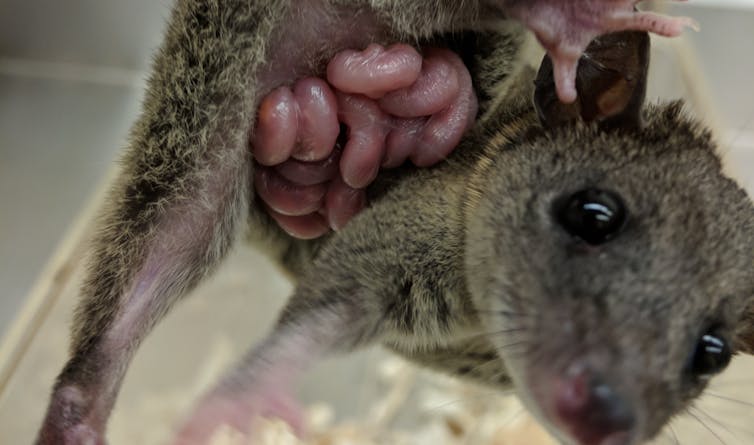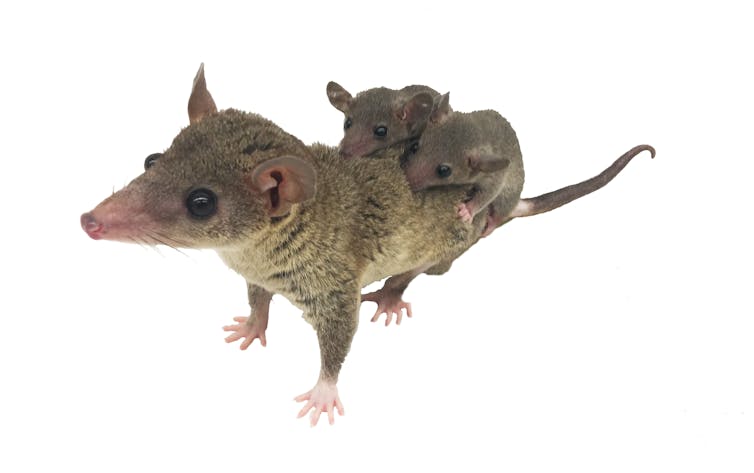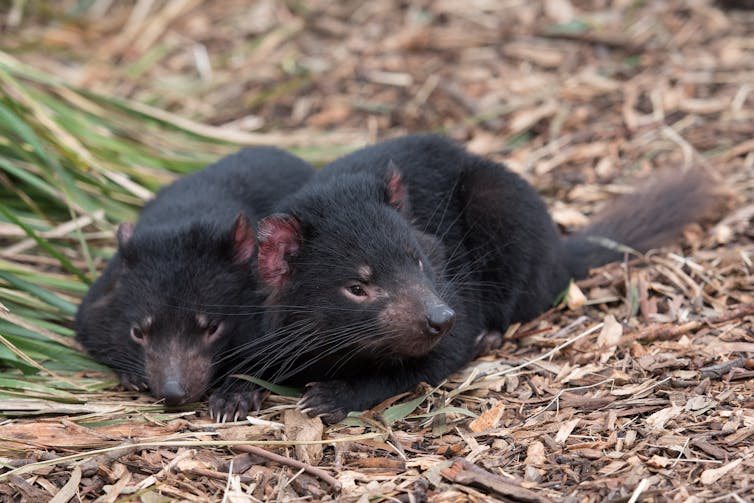New research could lead to a pregnancy test for endangered marsupials
- Written by Oliver Griffith, ARC DECRA Fellow, University of Melbourne
Many women realise they are pregnant before they’ve even done the test – perhaps feeling a touch of nausea, or tender, larger-than-usual breasts.
For a long time, biologists had thought most marsupials lacked a way to recognise a pregnancy.
But new research published today shows a marsupial mum knows – in a biological sense – when she’s carrying a young one before they make their journey to the pouch.
Read more: All female mammals have a clitoris – we're starting to work out what that means for their sex lives
This knowledge changes how we think pregnancy evolved in mammals. It may also help in breeding programs for threatened or endangered marsupials by contributing to new technologies such as a marsupial pregnancy test.
Marsupials do things differently
When people think of marsupials – animals that mostly rear their young in a pouch (although not all marsupials have a pouch) – kangaroos and koalas tend to spring to mind. But marsupials come in a range of shapes and sizes.
 A red-necked wallaby with a joey.
Pixabay/sandid
A red-necked wallaby with a joey.
Pixabay/sandid
Australia has about 250 species of marsupials, including wombats, possums, sugar gliders, the extinct Tasmanian tiger, and several endangered species such as the Tasmanian devil.
In addition to Australia’s marsupial diversity, there are also 120 marsupial species in South America – most of which are opossums – and just one species in North America, the Virginia opossum.
One thing all marsupials have in common is they give birth to very small, almost embryonic, young.
 An opossum with two day old young.
Oliver Griffith, Author provided
An opossum with two day old young.
Oliver Griffith, Author provided
Because marsupial pregnancy passes so quickly (12-40 days, depending on the species), and marsupial young are so small and underdeveloped at birth, biologists had thought the biological changes required to support the fetus through a pregnancy happened as a follow on from releasing an egg (ovulation), rather than a response to the presence of a fetus.
Marsupial pregnancy is quick
One way to explore the question of whether it is an egg or a fetus that tells the marsupial female to be ready for pregnancy is to look at the uterus and the placenta.
In marsupials, just like in humans, embryos develop inside the uterus where they are nourished by a placenta.
Previously, biologists thought all of the physiological changes required for pregnancy in marsupials were regulated by hormones produced in the ovary after ovulation.
If this hypothesis is right, then the uterus of pregnant opossums should look the same as the uterus of opossums that ovulate but don’t have the opportunity to mate with a male.
To test this hypothesis, my colleagues at Yale’s Systems Biology Institute and I examined reproduction in the grey short-tailed opossum.
 Grey short tailed opossum with young.
Oliver Griffith
Grey short tailed opossum with young.
Oliver Griffith
Signs of pregnancy
We looked at two groups of opossums: females that were exposed to male pheromones to induce ovulation, and females that were put with males so they could mate and become pregnant.
We then used microscopy and molecular techniques to compare females from the two groups. Contrary to the current dogma, we found that the uterus in pregnancy looked very different to those females that did not mate.
In particular, we found the blood vessels that bring blood from the mother to the placenta interface were only present in pregnancy. We also noticed that the machinery responsible for nutrient transport (nutrient transporting molecules) from the mother to the fetus was only produced in pregnancy.
While hormones may be regulating some aspects of maternal physiology, the mother is certainly detecting the presence of embryos and responding in a way that shows she is recognising pregnancy.
How this knowledge can help others
Given that recognition of pregnancy has now been found in both eutherian (formerly known as placental) mammals like ourselves and marsupials with the more ancestral reproductive characters, it appears likely that recognition of pregnancy is a common feature of all live bearing mammals.
Read more: Sexual aggression key to spread of deadly tumours in Tasmanian devils
But this knowledge does more than satisfy our curiosity. It could lead to new technologies to better manage marsupial conservation. Several marsupials face threats in the wild, and captive breeding programs are an important way to secure the future of several species.
 Two Tasmanian devils.
Pixabay/pen_ash
Two Tasmanian devils.
Pixabay/pen_ash
One such species is the Tasmanian devil, which faces extinction from a dangerous contagious cancer. Captive breeding programs may be one of the only mechanisms to ensure the species survives.
But management can be made more difficult when we don’t know which animals are pregnant. Our research shows that maternal signals are produced in response to the presence of developing embryos. With a bit more research, it may be possible to test for these signals directly.
New reproductive technologies are likely crucial for improving outcomes of conservation programs, and this work shows, that to do this we first need a better understanding of the biology of the animals we are trying to save.
Authors: Oliver Griffith, ARC DECRA Fellow, University of Melbourne



